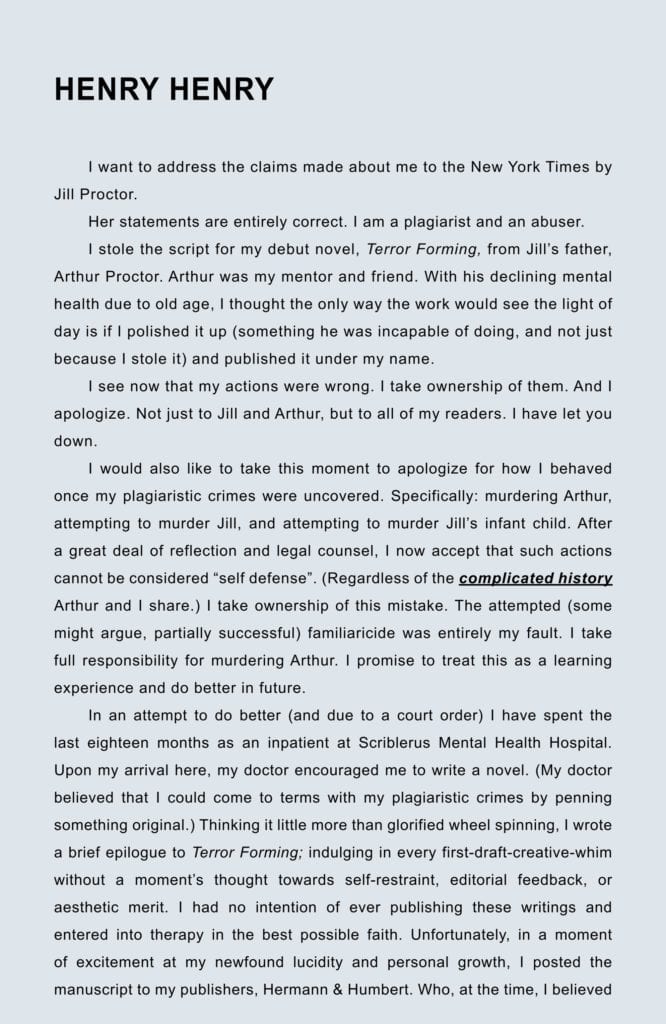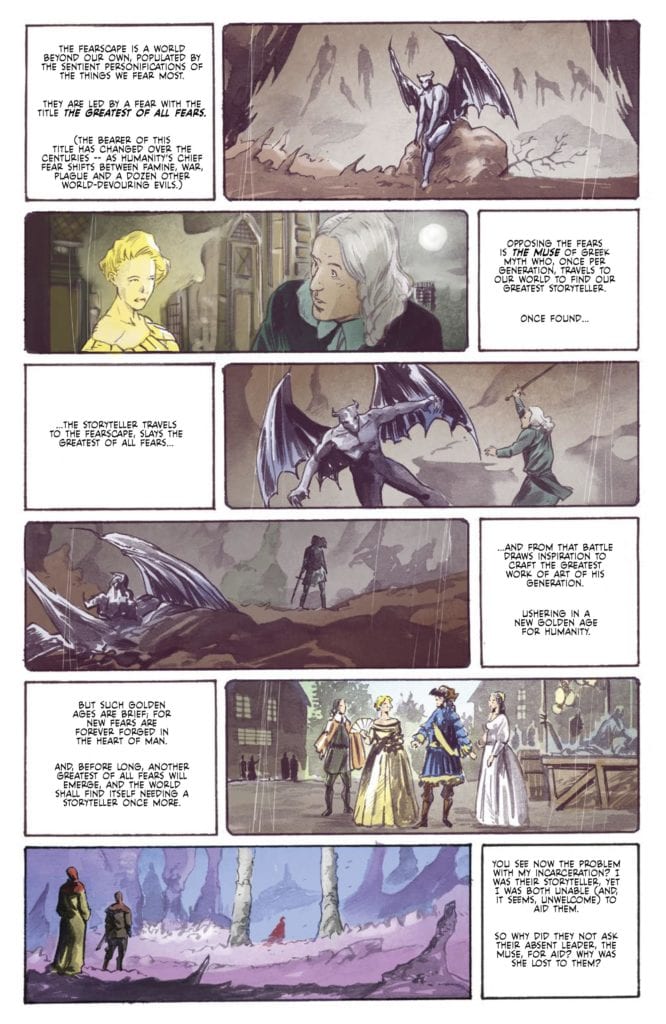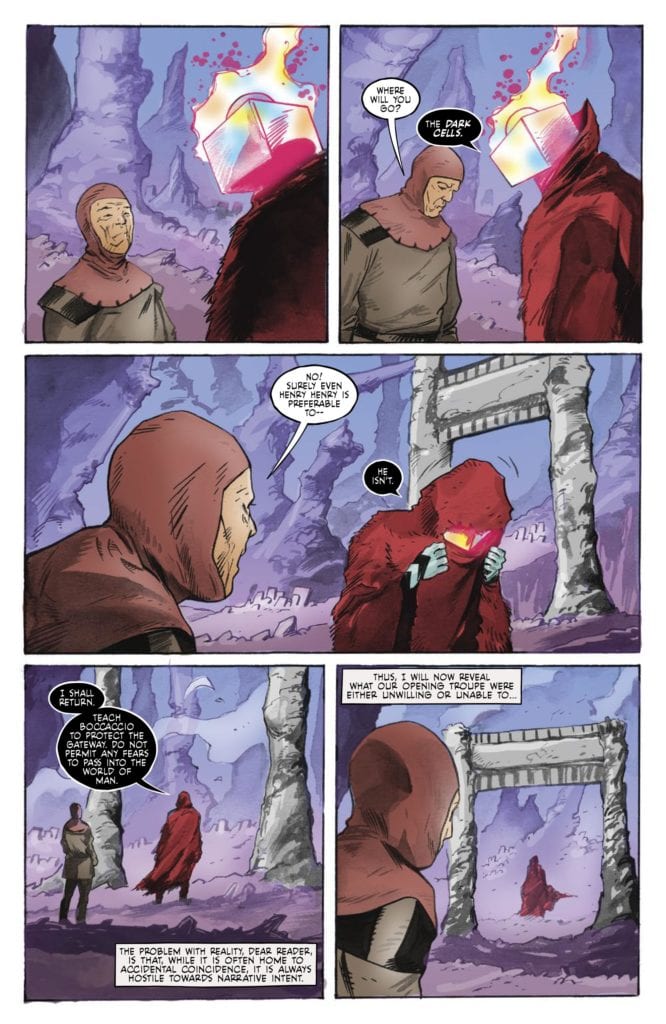A Dark Interlude #1, out today from Vault Comics, is the beginning of a new series that takes place after the events of the Fearscape, though it is able to stand on its own and welcome new readers while also pleasing fans of the previous series.
(Monkeys Fighting Robots also had the opportunity to interview writer Ryan O’Sullivan about the new series, which you can find here.)
About the book:
This series follows the events of Fearscape, a story which followed author Henry Henry as he is brought to a fantastic realm to battle humanity’s greatest fear by a Muse who believes him to be this generation’s greatest storyteller. The only problem is Henry Henry is a plagiarist. A Dark Interlude #1 picks up where Fearscape left off, with Henry Henry imprisoned for murder and attempted murder, and the muse — now reincarnated — living with Jill Proctor. This multitude of changes may make the story seem like it depends on its predecessor, but as the comic book repeatedly tells us, this is not a sequel. There are plenty of ways that A Dark Interlude #1 is able to inform us of what took place before and sets up what problems warrant a new story.

A Dark Interlude #1 Story
Many aspects of A Dark Interlude #1 make Ryan O’Sullivan’s story interesting and unique. The first of these aspects greets us immediately as we open the issue and are faced with paragraphs of text, rather than the panels one would expect to see from the medium. The issue does contain panels later, but that does not negate the impact of beginning solely with words. When expecting art and being greeted by text, it intrigues the reader to know why the writer chose to use this to open the series, rather than what the medium typically consists of. Some could argue that adding pages of pure text to a comic book is a cheap way to insert more story in less space, but that is not how O’Sullivan uses it. The text is not merely an explanation of what occurred in Fearscape, but instead is a letter written from our narrator, Henry Henry. The letter does give exposition about what happened before the issue, but it is also is a pleasant way to submerge the reader into the world of the issue. We get a feeling of who the character is, what happened in the past, and how his actions affected other characters.
O’Sullivan also makes A Dark Interlude #1 an intriguing read through the choice of narrator. Just as in Fearscape, Henry Henry is an egotistical narrator who often attempts to skew the narrative in his favor. It is rare to have such an unreliable narrator, and it changes how A Dark Interlude #1 is read. In all, O’Sullivan causes the story of the issue to be entertaining through its strange narrator, cool techniques such as the silent panel, and giving enough information for a new reader, even if they have no understanding of Fearscape.

Art
The illustrations of Andrea Mutti are what make much of A Dark Interlude #1 an enjoyable experience. Despite having the fantastical realm of the Fearscape to explore, much of the issue centers around characters in the typical world. In these scenes, Mutti’s work with facial expressions comes heavily into play. The issue uses the technique of a silent panel multiple times as a dramatic pause in a scene. In these panels, when no word bubbles are present to take any attention away, the facial expressions become the only point of focus. Mutti delivers on this front and can portray complex emotion on characters’ faces in these panels. However, while Mutti’s art style is pleasant to look at and is terrific at capturing emotion, it does feel like there was a missed opportunity for the art to be stunning for new readers. This may be partly because the issue largely centers on the real world instead of the Fearscape, and while the art is very well done and fits the story here, one hopes that future issues will allow the art team to go nuts and fully explore the fantasy realm. (The smart money says they will.)
A Dark Interlude #1 features the wonderful coloring talents of Vladimir Popov. There is a pleasing contrast between the palette used for the realm of the Fearscape and the real world. Not only are there distinct areas due to this, but each realm has its own unique tone due to these palettes. My only hope for future issues is that Popov uses even more variety to reflect the different tones of each scene.

The lettering of A Dark Interlude #1 fits wonderfully with the story and allows the issue to flow naturally. Andworld Design also uses speech bubbles in an interesting way in the issue. When we finally are able to see our narrator in person, his entire face is covered by the speech bubble of someone talking to him. Why this was done is a question in terms of the writing, but the execution of having a word bubble cover his face built suspense, and is not an often seen form of lettering.
Conclusion
A Dark Interlude #1 is the beginning of a new journey in the world of Fearscape. Events are starting to build, and it is clear there are many thrilling stories to await in the series. The art pairs nicely with the story and provides for an excellent, captivating read.

